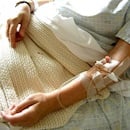
The Importance of Interprofessional Collaboration
Jodi O’Brien, RN
What do Tori Spelling and interprofessional collaboration have in common? Spelling and her baby might not be alive today had it not been for the dedicated nurses and physicians who coordinated their efforts to keep the two alive.
In the fall of 2012, the Reality-TV star and her husband, Dean McDermott, opened up about their scary ordeal involving her pregnancy with their fourth child, Finn. Spelling nearly lost her life and that of her unborn child due to placenta previa, a condition in which the placenta covers the opening of the cervix. Life-threatening hemorrhaging necessitated bed-rest for 10 weeks until Spelling was able to deliver (by cesarean section) a healthy baby boy.
While her story highlights a terrifying condition, it is clear that Spelling’s healthcare team had to work quickly and collaboratively in order to save the lives of both mother and baby.
Interprofessional collaboration, (better known as IPC), is the latest buzzphrase among nurses and other health professionals. Interprofessional collaboration occurs when multiple health professionals from different specialties work collaboratively with patients, their families, and caregivers to deliver high-quality care (WHO, 2010). You may already collaborate with other health professionals. Whether you have some experience with interprofessional collaboration or none at all, there are some things to keep in mind to enhance collaboration while caring for patients -- regardless of your health care setting.
Historically, patient errors in U.S. hospitals range in severity and complexity from simple medication errors to fatal compromises in patent safety, and poor communication has been cited as the number one culprit (JCAHO, 2006). These widespread errors not only harm our patients but are costly and largely preventable.
Most healthcare leaders agree that the adoption of IPC by all health professionals will be instrumental in a sustainable healthcare environment as we ride the wave of healthcare reform. IPC, as the new standard of individualized care delivery, will not only reduce patient errors and healthcare costs but will create improvements in communication among healthcare providers, optimize the health of the patients and families they serve, and enhance the overall state of healthcare organizations.
So how do you practice IPC in your setting? Experts agree that with tools such as Team STEPPS and SBAR, you are well on your way. Direct and open communication between all members of the patient’s healthcare team will ensure the best delivery of care. The inclusion of allied health professionals, such as physical therapists and pharmacists in communications, ensures patient safety and an integrated approach to patient care.
And while health professionals who exercise interprofessional collaboration skills are well-intentioned, a word of caution is advised: Healthcare providers should recognize the individual contributions of each professional involved in the direct care of the patient.
Biography:
Jodi O’Brien, RN graduated from the University of Rochester in 2002. She has worked as a medical surgical nurse and has held adjunct faculty teaching positions for local colleges in San Diego. She currently works as an OR nurse, where she cares for women and newborns and is a graduate student in the Executive Nurse Leadership Program at the University of San Diego. This is her first story for RN.com.
References:
Agency for Healthcare Research and Quality. Team STEPPS. (2013).
Institute for Healthcare Improvement. (2013). SBAR Technique for communication: a situational briefing model. TechniqueforCommunicationASituationalBriefingModel
Interprofessional Education Collaborative Expert Panel. (2011). Core competencies for interprofessional collaborative practice: Report of an expert panel. Washington, DC :Author.
Joint Commission on Accreditation of Healthcare Organizations [JCAHO]. (2006).
World Health Organization [WHO]. (2010). Framework for action on interprofessional education and collaborative practice. Health Professions Networks. Nursing & Midwifery Human Resources for Health.




